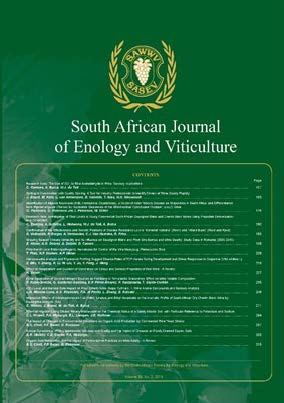Sorting in Combination with Quality Scoring: A Tool for Industry Professionals to Identify Drivers of Wine Quality Rapidly
DOI:
https://doi.org/10.21548/39-2-3203Abstract
Quality plays an important role in the criteria directing wine product development. The evaluation of sensory characteristics associated with wine quality, as perceived by industry professionals, is therefore important. We investigated the suitability of the free-sorting sensory evaluation method, in combination with wine quality scoring using a 20-point scoring system, to determine the drivers of quality. Eight commercial South African Sauvignon blanc wines were assessed by a panel of 24 wine industry professionals. Free sorting with a verbalisation step to describe the groups, followed by quality scoring using score sheets routinely used in the wine industry, was performed. A multivariate sensory map was constructed using DISTATIS to explain the similarities and differences amongst the set of wines. Correspondence analysis (CA) was applied to the group descriptors, and CA deviates were calculated. Pearson’s correlation coefficients between CA deviates and the quality scores were calculated to identify the drivers of quality. Significant differences in quality were observed between the wines. The sensory attributes “passion fruit”, “green pepper”, “peas”, “asparagus” and “green” were frequently cited by the panel for the wines that received the highest average quality scores, and these attributes were identified as drivers of quality. In this study, a procedure is presented that combines sorting and quality scoring to investigate the relationship between sensory attributes and quality scores to identify the drivers of wine quality. Industry professionals and research environments can use this procedure to determine drivers of wine quality in a single evaluation session.
Downloads
Downloads
Published
Issue
Section
License
A copyright form will be e-mailed to the corresponding author when the manuscript has been accepted for publication.
In principle, the Author agrees to the following when he/she signes the copyright agreement:
I hereby assign to the SOUTH AFRICAN SOCIETY FOR ENOLOGY AND VITICULTURE (SASEV) the copyright of the text, tables, figures, supplementary material, illustrations and other information (the Material) submitted with the manuscript to be published in SOUTH AFRICAN JOURNAL OF ENOLOGY AND VITICULTURE (SAJEV) (the "Article"). The copyright becomes effective from the date the Article has been accepted for publication in SAJEV.
This is an open access journal, and the authors and journal should be properly acknowledged, when works are cited.
Author's may use the publishers version for teaching purposes, in books, theses, dissertations, conferences and conference papers.
A copy of the authors' publishers version may also be hosted on the following websites:
- Non-commercial personal webpage or blog.
- Institutional webpage.
- Authors Institutional Repository.
The following notice should accompany such a posting on the website: This is an electronic version of an article published in SAJEV, Volume XXX, number XXX, pages XXX - XXX, DOI. Authors should also supply a hyperlink to the original paper or indicate where the original paper (www.journals.ac.za/index.php/sajev/) may be found.
Authors publishers version, affiliated with the Stellenbosch University will be automatically deposited in the University's Institutional Repository SUNScholar.
Articles as a whole, may not be re-published with another journal.
The following license applies:
Attribution CC BY-NC-ND 4.0

